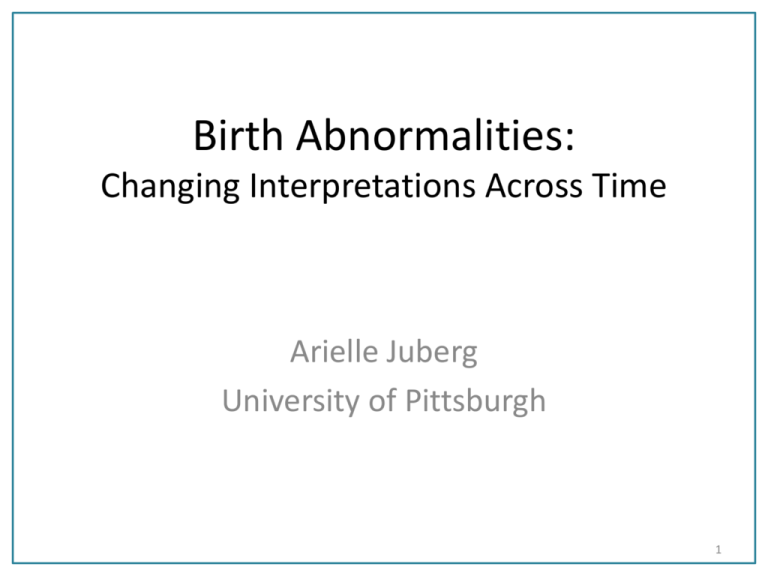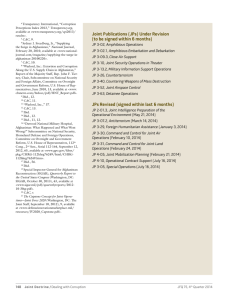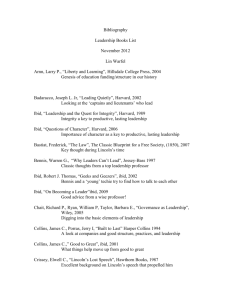Birth Abnormalities: Changing Interpretations Across Time
advertisement

Birth Abnormalities: Changing Interpretations Across Time Arielle Juberg University of Pittsburgh 1 What is a birth abnormality? • A congenital disorder is an “abnormality of structure, and consequently, function of the human body arising during development”1 • Described as congenital disorders, birth abnormalities, or birth defects 2 Commonly-known Birth Defects • Congenital heart defects • Cleft Lip and Cleft Palate Cleft Lip • Spina Bifida • Club Foot Spina Bifida • Down Syndrome Club Foot 3 Less well-known birth defects • Anencephaly: Brain fails to develop, resulting in small or missing hemispheres2 • Hermaphrodism: External genitalia and internal reproductive organs display male and female characteristics3 •Conjoined twins •There are 7 types of conjoined twins, depending on where the individual bodies are fused 4 Studying Birth Defects Today • Teratology: the study of malformations or serious deviations from the normal type in developing organisms5 • Birth abnormalities are understood, interpreted, and treated in the scientific and medical fields today 5 Historical Views • How were birth abnormalities understood in previous societies? • What can this tell us about societal attitudes and medical knowledge? Beliefs in society about disability Availability of treatment options Medical Knowledge How were birth defects understood? Religious Views 6 Disabilities in the Ancient World Features in Society: • Polytheistic (worshipping many gods) • Paternalistic (father is leader of household) • Agriculture is dominant • The rise of empires: Hittites (1600-1200 BCE), Assyrians (911-612 BCE), Babylonians (626529 BCE) • Rise of Greek city-states and the Classical Age (448-404 BCE) • The Roman Empire (27 BCE- 476 AD) 7 What was the cause of deformity? 1) Maternal imagination: Images that the mother views during conception or in the early months of her pregnancy can imprint themselves on the fetus Example: Galen of Pergamum (129-215 BCE) suggests looking at a portrait of a beautiful child to give birth to an attractive infant6 Example: Christian Bible, Genesis 30:39 “And the flocks conceived at the sight of the rods” Jacob places speckled branches in front of mating sheep in order to produce speckled lambs 8 2) Conditions during conception and the womb: the temperature and age of the seed, the direction of the wind, and the quality of water7 3) The sins of the parents caused the deformity. • Conceiving after bloodletting or a long journey leads to epilepsy in children • Union with a woman during her menstruation produces children with abnormalities; Leviticus 18:19 in Christian Bible warns against this8 9 4) Children with disabilities are signs and warnings from the gods • Teratoscopy or fetoscopy involve interpreting abnormal births for signs of the future12 • Abnormal child seen as sign of conflict, loss of home or land, famine, or a power struggle13 • “Monsters, signs, portents, prodigies are so called because they indicate, show, portent, and predict” - Cicero (106-43 BCE)14 10 Reactions in Babylonia • The head of the household performed a religious ritual to the gods and disposed of the infant in a river “Šamaš, I have turned to you! Avert from me the evil of this anomaly. May it not reach me. May its evil be far from my person, so that I may daily bless you!” 17 11 Reactions in Greek City-States • Lack of medical care meant most children died before or shortly after birth • Child with abnormalities exposed in remote area to die • The militaristic city-state Sparta required all deformed children to be abandoned; they would not be fully productive members20 12 The Greek God Hephaestus The Greek God Hephaestus is the middle figure in this scene, painted on a Greek amphora. His malformed feet are clearly visible 13 Reaction in Roman Empire • Head of family (paterfamilias) responsible for disposing of abnormal child, often by throwing in the Tiber River • In Imperial era, royal and upper class families owned individuals with disabilities for amusement (similar to a side-show)22 • The teraton agora, or monster market, sold slaves with deformities23 • Individuals with disabilities (particularly hermaphrodites) also the targets of violence from mobs of citizens24 14 Were these children part of society? • Although called monsters, prodigies, and portents, children with disabilities not seen as supernatural or non-human St. Augustine (354-430 AD) in City of God: Individuals with disabilities show greatness and supremacy of God Demonstrate the beauty of normal humans27 15 Pre-Modern Europe Major Events 1060: William the Conqueror invades England 1517: Protestant Reformation 1095: First Crusade 1348-1358: Black Death 1648: Peace of Westphalia 1453: Fall of Constantinople 1000 1200 1300 1400 1500 1600 1700 1800 1543: Vesalius publishes On the Fabric of the 1674: Leeuwenhoek’s microscope Human Body 1628: Harvey’s An Anatomical Study of the Motion of the Heart 1796: Edward Jenner experiments with inoculation 1665: Robert Hooke coins the word cell Medical History 16 Features of European Society • Monotheistic; Catholic Church holds significant power until challenged by Protestant Reformation • Constant warfare • The rise of the sovereign state and the power of the monarchy • Feudal system dominant until the Black Death (1348-1358), rise of city-states, and merchant class • International trade increases; discovery of America 17 Causes of Deformity From the ancient world: • Maternal images and imagination • Unclean intercourse during menstruation • Punishment for sins of parents • Warning to present or future society Advice from this period: Pregnant women should not gaze at disturbing or unattractive images for the first 30 to 35 days (for a male child) or 40 to 42 days (female child) of their pregnancy29 18 • Human-animal hybrids existed mainly in legend • Abnormalities compared with animal features possibly because defied other characterizations Figure 28. Prodigious figure of a child having the face of a frog Ambroise Pare , On Monsters and Marvels In pre-modern Europe, a child born with anencephaly was often said to have the face of a frog. The underdeveloped brain and skull created facial qualities that could be compared to a frog 19 On Monsters and Marvels 1573 1) the glory of God 2)his wrath 3) too greatly a quantity of seed 4) too little a quantity 5) the imagination 6) the narrowness or smallness of the womb 7) the indecent posture of the mother 8) fall or blows to the womb 9) hereditary or accidental illness 10)rotten or corrupt seed 11) mixture or mingling of seed 12) Artifice of wicked beggars 13) through demons and devils Ambroise Pare, On Monsters and Marvels 20 The Monster of Ravenna The birth of this malformed child was seen as a sign of the defeat of the Italians at the Battle of Ravenna “It is evident what evil the monster had meant for them! It seems as if some great misfortune always befalls the city when such things are born.” -Lucca Landucci, (1436-1516) Florence, Italy Ambroise Pare, On Monsters and Marvels 21 In this advertisement, an infant born with ‘ruffle-like’ skin is seen as a warning against vanity. Ruffles were popular details on clothing at the time. The author of this advertisement viewed the birth as a visual sign of his society’s conceit. The True Discription of a Childe with Ruffes from 1566 22 “Watch! For the Lord our God comes”33 A ‘manne chylde, having three armes, three legges and very terrible to beholde.’ From 1581 23 Pregnancy and Childbirth in Pre-Modern Europe Birth Superstitions •Legend holds that Countess Margaret gave birth to 365 children in one day35 •A sooterkin was a mole-like creature present in the womb with a child; it acted as a parasite and sucked on the fetus’ blood36 The picture of Dorothy, pregnant with many children Ambroise Pare, On Monsters and Marvels 24 Broadsides: To Entertain and Inform The Form and Shape of a Monstrous Child Borne at Maydstone in Kent From 1568 25 Lazarus Colloredo and his twin A broadside advertising Colloredo 26 •Images of the Gonzales family, who suffered from congenital hypertrichosis, extreme hairiness. •Although originally from the Canary Islands , the family was relocated to Europe Their fashionable clothing shows that the family lived in comfortable surroundings 27 The Scientific Revolution • Occurred from approximately 1543 to the 18th century •Ancient and medieval theories replaced with new ideas •Fields of anatomy and biology expanded •Dissection more acceptable for physicians A more scientific illustration from 1708 28 Rise of the Sideshow This man was nicknamed “Lionel the Lion-man” by Barnum and Bailey Circus 29 Krao with a European gentleman and a sideshow poster featuring Krao. 1872: The Burmese family of Moung-Phoset, Maphoon, Mah-Me, and a nonhairy relative. 30 Abnormalities in the Modern World •Medical advances have improved treatment options and quality of life for infants with abnormalities •Fetal and infant surgery can correct abnormalities, including cleft lip, cleft palate, and many heart defects •Many conditions can be diagnosed in the womb •Research into the human genome has helped parents predict if they will pass a genetic condition to their child 31 Abnormalities in the Modern World “My husband and I felt so devastated and guilty and alone. How could this have happened? We did all the right things. I took care of myself and followed the doctor’s instructions during my pregnancy. There was no one else in our families that had been born with this birth defect. I felt lost”48 32 Living with Abnormalities Children born with abnormalities may need: • Medical equipment • Specialized care • Frequent doctor’s visits Arrangements for health insurance and education can be time-consuming and difficult 33 Thalidomide •Thalidomide was meant as a sleeping aid but prescribed to pregnant women to treat anxiety and nausea •The drug caused serious birth abnormalities for hundreds of children50 •Mothers of thalidomide babies felt responsible for the conditions of their children •Thalidomide led to stricter tests to determine a drug’s impact on a fetus An infant with birth abnormalities from thalidomide 34 Americans with Disabilities Act 1990 President Bush signing the Americans with Disabilities Act into law, 1990 Amsvans.com 35 Discrimination in the 20th Century • Sideshows remained popular until late 1930s • During the Holocaust in Nazi Germany (1939-1945) as many as 200,000 individuals with disabilities were killed at Hadamar Concentration Camp52 • Forced sterilization policies were carried out against individuals with disabilities in many countries 36 Contemporary Beliefs • Belief in material imagination can be compared to playing classical music for the fetus55 • In 1958, a publication still argued that emotional distress to the mother could negatively affect the fetus56 • In 2010, a video circulating on the Internet claimed that “Cat Gives Birth to Puppy”58 37 Contemporary Concerns • Ethical and legal issues exist around infants with birth abnormalities and their projected quality of life • Does our current medical knowledge focus more on diagnosis than treatment? • Do our methods of handling birth deformities add more difficulties to individuals? 38 The Future “We no longer gawk at the handicapped, disfigured, or mentally ill in freak shows, but do we regard them as equals, or as friends?”62 • How can we better predict and prevent birth abnormalities? • How can we ensure that individuals with these abnormalities receive proper care and lead productive lives in society? 39 Contact Information Arielle Juberg University of Pittsburgh 2011 Arielle.juberg@gmail.com 40 Works Cited 1 Congenital disorder. 2010. In Encyclopædia Britannica. Retrieved 16 Dec, 2010, from Encyclopædia Britannica Online: http://www.britannica.com/EBchecked/topic/132266/congenital-disorder 2 Anencephaly. 2010. In The Free Dictionary. Retrieved 16 Dec, 2010 from The Free Dictionary: http://www.thefreedictionary.com/anencephaly 3 Hermaphrodism. 2010. In The Free Dictionary. Retrieved December 16, 2010 from The Free Dictionary: http://www.thefreedictionary.com/hermaphrodism 4 Ibid 5 Teratology. 2010 In Merriam-Webster. Retrieved 16 Dec, 2010 from MerriamWebster: http://www.merriam-webster.com/dictionary/teratology 6 Stolm M. 2000. Birth in Babylonia and the Bible: Its Mediterranean Setting. Groningen: Styx Publications. Pg. 157 7 Garland, Robert. 1995. The Eye of the Beholder: Deformity and Disability in the Graeco-Roman World. Ithaca: Cornell University Press. Pg. 150 8 Pare, Ambroise. 1982 ed. On Monsters and Marvels. Trans. Janis L. Pallister. Chicago: The University of Chicago. Pg. 5 9 Garland pg. 150 10 Stol pg. 167 11 Bates, A.W. 2005. Emblematic Monsters: Unnatural Conceptions and Deformed Births in Early Modern Europe. Amsterdam: Rodopi. Pg 76. 12 Ibid. pg. 26 41 13 Stol 2000 Works Cited 14 Bates pg. 49 15 Ibid. pg. 26 16 Garland 17 Stol pg. 165 18 Garland pg. 12-13 19 Stol pg. 165 20 Garland pg. 14 21 Ibid. pg. 29 22 Ibid. pg. 45 23 Ibid. pg. 46-7 24 Ibid. pg. 68 25 Ibid. pg. 45-49 26 Ibid. pg. 68 27 Wilson, Dudley. 1993. Signs and Portents: Monstrous Births from the Middle Ages to the Enlightenment. London: Routledge. Pg. 58 28 Ibid. pg. 58 42 Works Cited 29 Graves, Rolande. 2001. Born to Procreate: Women and Childbirth in France from the Middle Ages to the 18th Century. New York: Peter Lang. pg. 56 30 Bates 118 31Pare 32 Bates 27 33 Ibid. pg. 225 34 Ibid. pg. 16 35 Bondeson, Jan. 2000. The Two-Headed Boy and Other Medical Marvels. Ithaca: Cornell University Press. Pg. 69 36 Bates, pg. 128 37 Ibid. pg. 46 38 Ibid. pg. 152; Bondeson pg. 6 39 Bondeson pg. vii 40 Ibid. pg. 11 41 Wilson pg. 108 43 Works Cited 42 Bondeson 30 43 Deutsch, Helem and Feliciy Nussbaum, eds. 2000. Defects: Engendering the Modern Body. Ann Arbor: The University of Michigan Press. Pg. 97 44 Bondeson pg. 27, 29 45 Iannucci, Liza. 2000. Birth Defects. Berkeley Heights: Enslaw Publishers Inc. pg. 16. 46 Murkoff, Heidi and Sharon Mazel. 2008. What to Expect When You’re Expecting. 4th ed. New York:Workman Publishing. 47 The American College of Obstetricians and Gynecologists. 2005. Your Pregnancy and Birth. 4th ed. Washington D.C. 48 “Elena’s Story.” Online Posting. 2009. Real Stories, Spina Bifida Association of America. July 14, 2010.www.spinabifidaassociation.org 49 Ibid. 50 The Insight Team of the Sunday Times of London. 1979. Suffer the Children: The Story of Thalidomide. New York: The Viking Press. 51 Ibid. 52 Wilson pg. 189 44 Works Cited 53 54 55 56 57 58 59 60 61 Ibid. Bondeson, 35 Murkoff, pg. 248 Strean, Lyon P. 1958. The Birth of Normal Babies. New York: Twayne Publishers. Ibid. “Cat Gives Birth to Puppy in Georgia.” 2010. Russia Today. 26 July. Walters, LeRoy. 1983. “Ethical and Legal Issues in the Treatment of Handicapped Newborns.” In Genetic Disorders and Birth Defects in Families and Society: Toward Interdisciplinary Understanding. Ed. Joan O. Weiss, Barbara A. Bernhardt, Natalie W. Paul. White Plains: March of Dimes Birth Defects Foundation. Cohen, Libby G. 1990. Before Their Time: Fetuses and Infants at Risk. Washington D.C: American Association on Mental Retardation. The Insight Team of the Sunday Times of London. 45 Works Cited 62 Hsia, Edward Y. 1983. “To Strive for the Best, Together” In. Genetic Disorders and Birth Defects in Families and Society: Toward Interdisciplinary Understanding Conference. Barbara A. Bernhardt, Natalie W. Paul., Joan O. Weiss, eds. White Plains: March of Dimes Birth Defects Foundation. 63 Ibid 46






